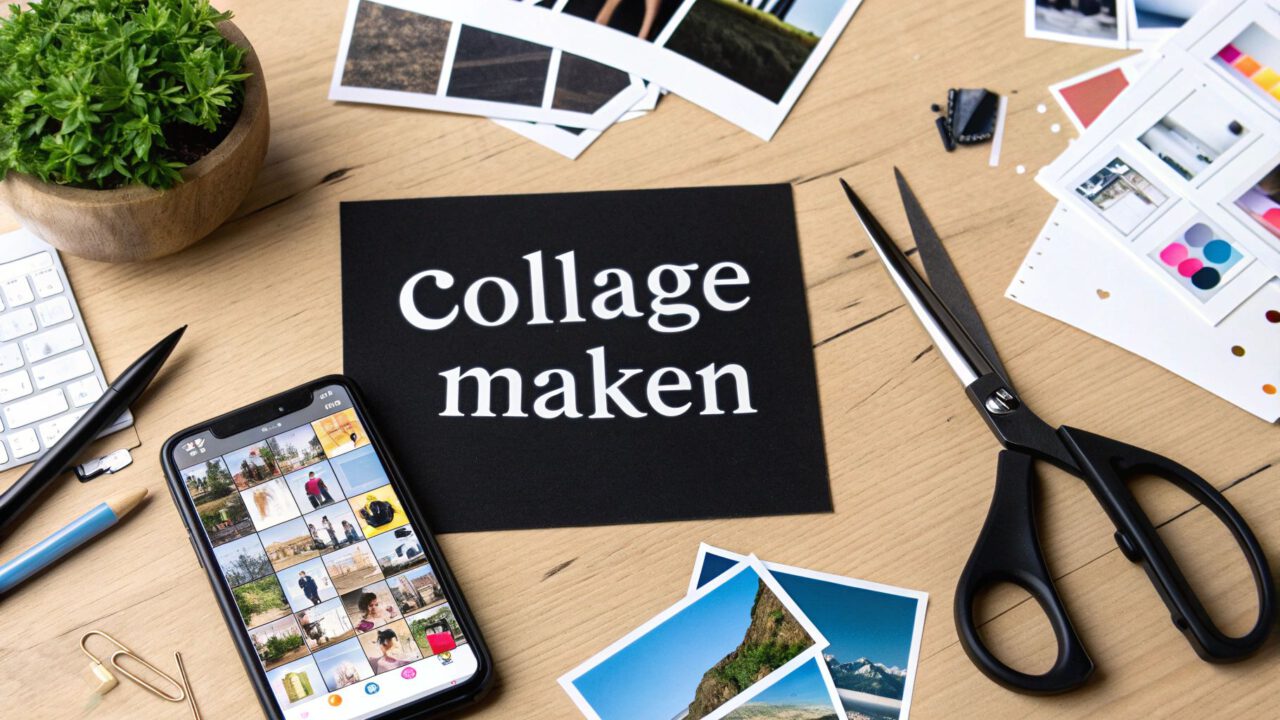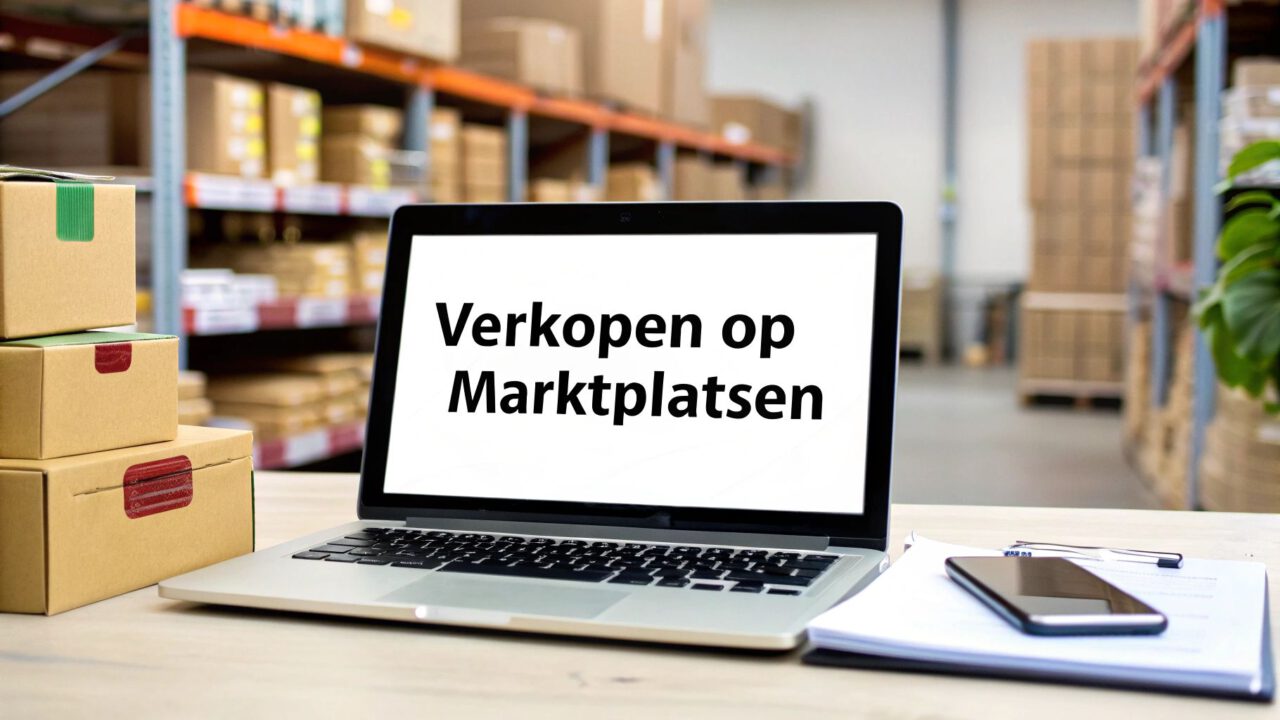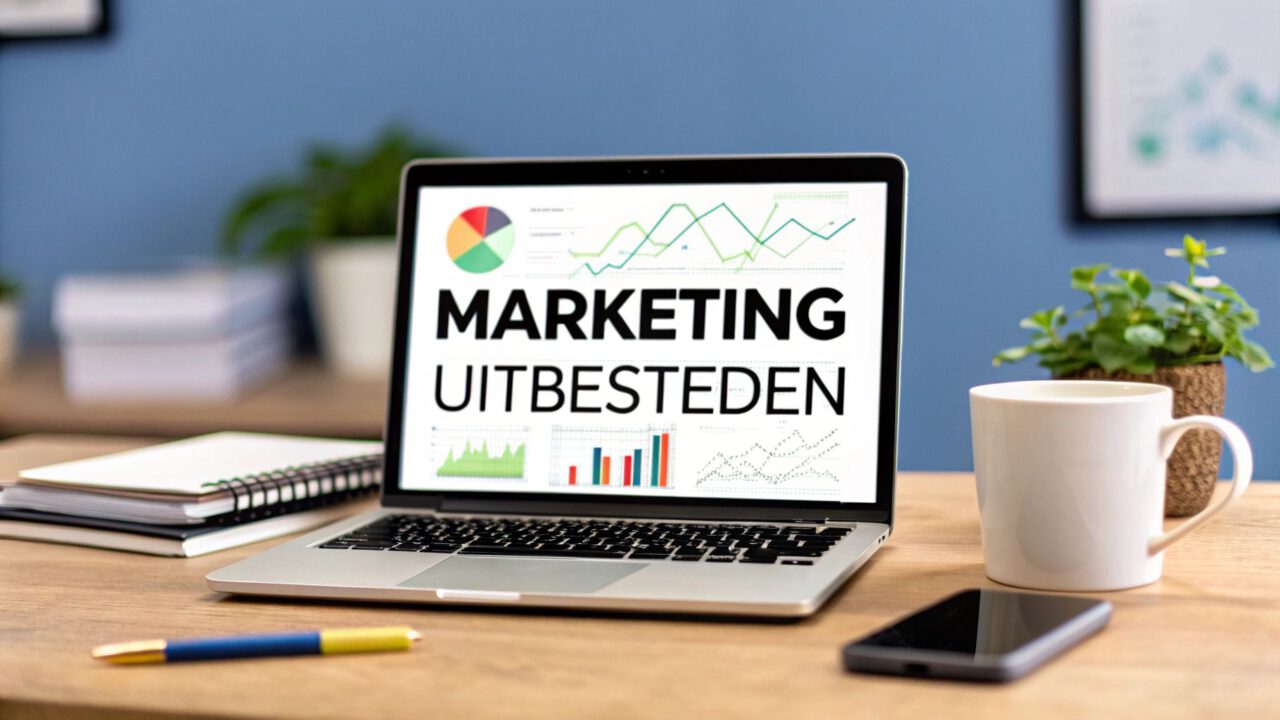Creating a mood board is much more than just pasting together some inspiring images. Think of it as the fastest way to turn an abstract idea into a visual plan that the whole team can immediately understandIt's the foundation for a strong, consistent image and ensures that everyone is on the same page from the outset – the perfect start for smooth collaboration.
Why a mood board speaks the language of your project
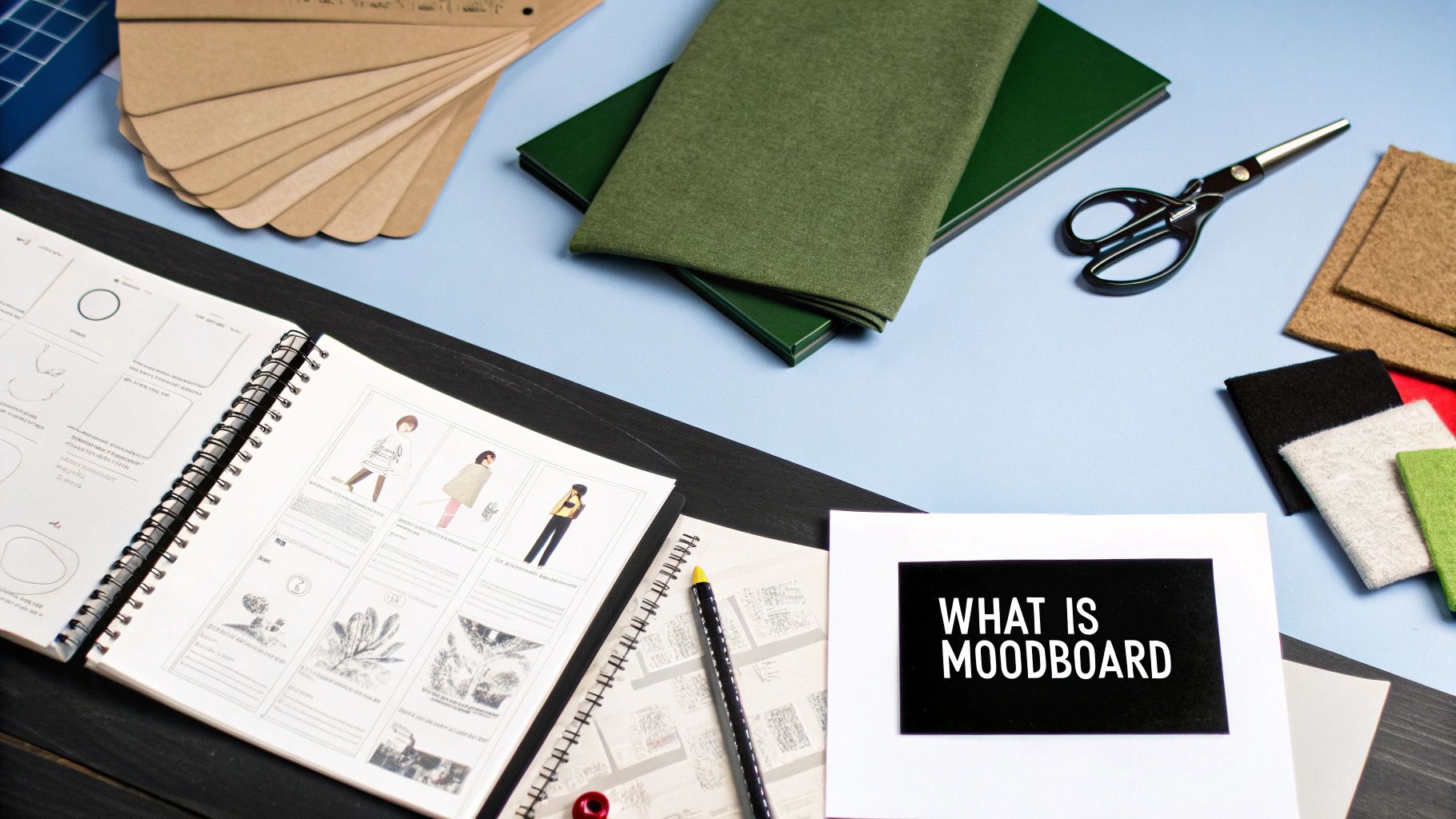
A mood board is so much more than a collage of pretty images. It's a strategic tool that lays the foundation for every successful collaboration. Think of it as a visual, universal language that team members, partners, and clients instantly understand, often much faster and more clearly than words can ever convey.
Imagine: you're developing a new brand identity. Terms like "modern," "fresh," or "luxurious" can mean something completely different to everyone. Without a shared visual reference point, miscommunication is almost inevitable. This, in turn, leads to endless rounds of corrections and a lot of frustration on both sides.
The power of a shared vision
A good mood board solves that problem by making abstract ideas tangible. It creates a shared starting point and ensures that everyone—from the marketer to the web designer—works from the exact same visual brief. This not only strengthens collaboration but also makes the entire process much more efficient.
The benefits of this approach are even measurable. In Belgium, the mood board plays a central role in the creative process. For example, no less than 69% from the professional designers and marketers that it increases the efficiency of brainstorming sessions by at least 30% increases. In addition, 53% of respondents that the risk of misunderstandings with customers decreased significantly, resulting in projects being completed on average 15% were completed faster. Want to learn more about the impact of visual tools? On YouTube you will find countless examples.
A mood board bridges the gap between an abstract idea and its concrete execution. It ensures that the client's vision perfectly aligns with the creative team's final deliverable.
By investing in such a clear, visual compass from the start, you'll lay a rock-solid foundation for your project. It's not a luxury, but an essential component for smooth collaboration and a final result you can be proud of.
How do you choose the right tools for smooth collaboration?
The choice between a traditional, physical mood board or a digital one largely determines how your team will collaborate. It's more than a practical decision; it influences the entire creative dynamic. Both methods have their own charm and advantages, depending on your project and your team's preferred way of working. So the key question is: which is best for you? you workflow?
Physical cut-and-paste versus digital flexibility
A physical board—think a large piece of cardboard, scissors, glue, and a stack of magazines—is still unbeatable when tactility and texture are key. Sitting around a table together and physically moving images and samples often creates a unique, spontaneous energy. Ideal for facilitating a creative workshop and capturing direct, nonverbal feedback.
Digital tools excel in flexibility, especially for teams that work in different locations. With platforms such as Miro, Canva or Pinterest Everyone can contribute simultaneously, leave comments, and move elements around. Perfect for projects with a tight deadline where you need to gather continuous and rapid feedback.
The image below shows why teams create a mood board in the first place.
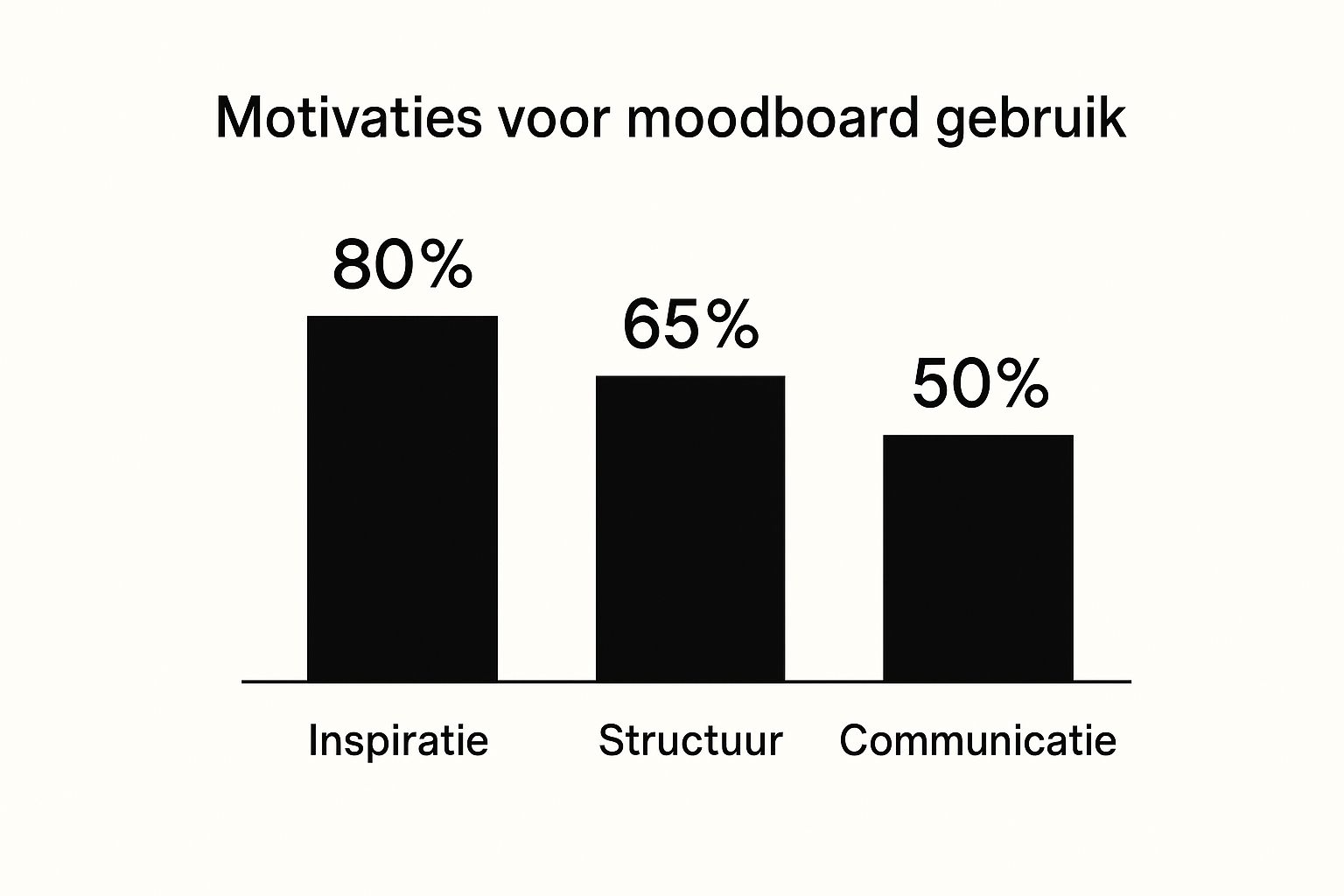
While getting inspired by 80% The main driver is that communication and providing structure also play a significant role. And these are precisely the elements that define good collaboration.
The best tool isn't necessarily the most advanced. It's the tool that lowers the barrier to collaboration, allowing everyone on the team to effortlessly contribute to the shared vision.
Did you know that mood boards really started to take off in Belgium around the 2000s, along with the first digital design software? The real breakthrough came after 2010. Today, no fewer than 82% Design schools are adopting digital tools as standard practice, a trend that has accelerated since 2018. This demonstrates how deeply the digital approach has become ingrained in our creative processes.
Comparison of physical and digital mood board tools
To help you make the right choice, I've compiled a table outlining the key differences, benefits, and ideal scenarios for both methods. Pay particular attention to the impact each method has on collaboration within your team.
| Feature | Physical Mood Board (Cardboard, scissors, glue) | Digital Mood Board (Canva, Miro, Pinterest) |
|---|---|---|
| Tangibility | High. Ideal for texture, materials, and color combinations. | Low. Limited to visual display on a screen. |
| Cooperation | Excellent for teams in the same physical space. Encourages direct interaction. | Perfect for remote teams. Work, comment, and share simultaneously. |
| Flexibility | Limited. Adjustments are time-consuming and sometimes messy. | Very high. Elements are easy to move, scale, and replace. |
| Share & present | Complicated. Requires a photo or physical presence. | Simple. Shareable via a link, exportable as a PDF or image. |
| Ideal for… | Interior design, fashion, product development, branding with physical elements. | Web design, UX/UI, digital marketing campaigns, projects with remote teams. |
The conclusion is simple: there is no 'best' method, only the method that best suits your project and team.
Ultimately, the goal is the same, whether you choose the charm of cutting and pasting or the efficiency of a digital tool: create a clear visual language that everyone understands and inspires. Are you considering investing in professional software or a workshop? Then don't forget to consider the subsidy options through the SME portfolioChoosing the right tool is the first, crucial step towards a successful creative project.
Finding inspiration that strengthens your vision
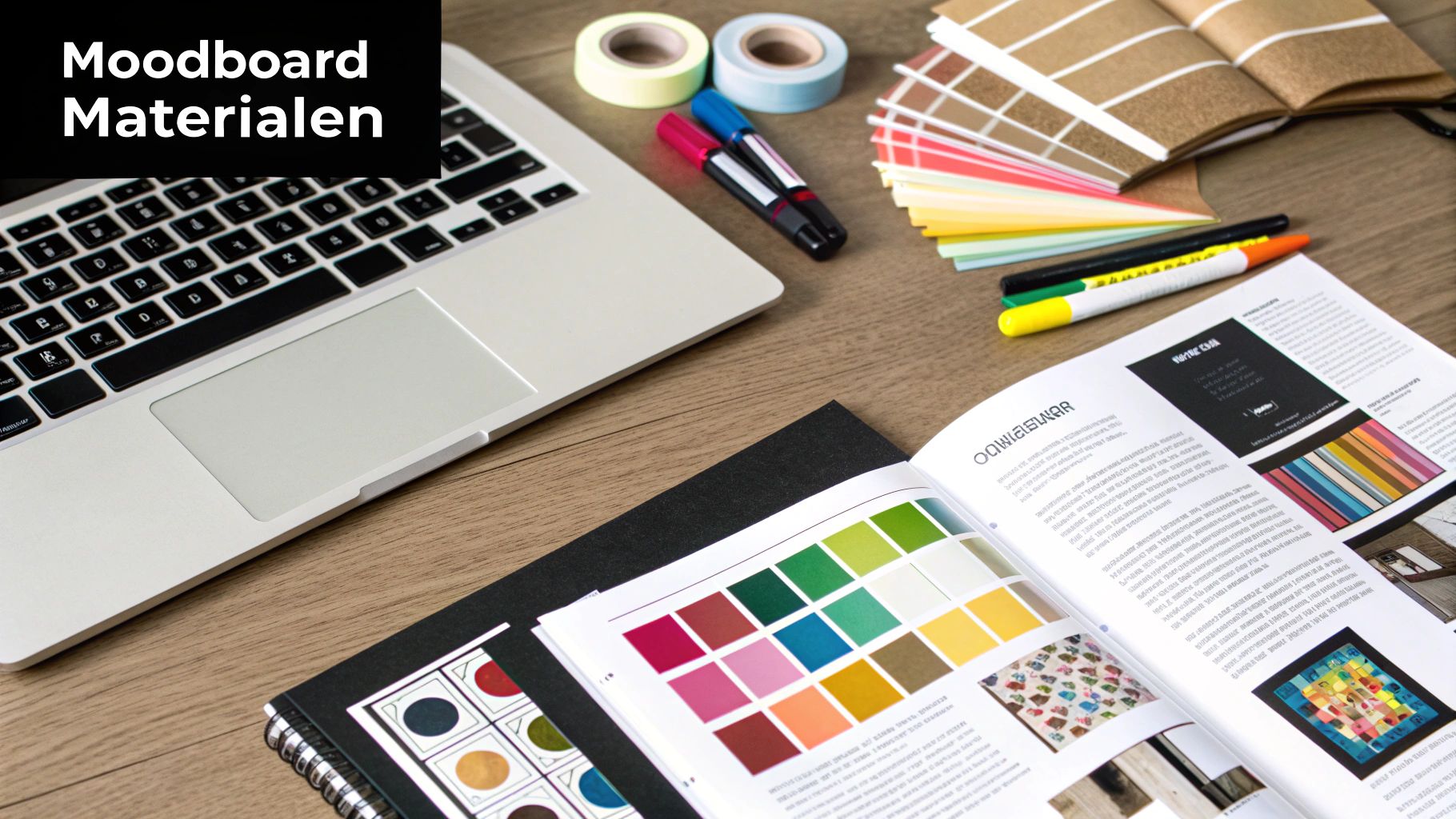
Okay, the tools are ready. Now begins the phase where you and your team shape the vision: the hunt for inspiration. This is more than just collecting some pretty images. It's a collaborative journey of discovery to build a collection that truly tells your story.
Start with the keywords that capture the essence of your project. Vague terms like "modern" won't help. Dig deeper. Are you working on branding for a sustainable coffee brand? Then words like artisanal, earthy, warm and community much better starting points.
These words serve as the compass for the entire team. They ensure everyone searches for images that are not only beautiful but also convey the right message and feeling.
Look beyond the usual suspects
Of course, platforms like Pinterest, Behance and Dribbble Great starting points. You'll find an inexhaustible source of high-quality images. But truly unique, personal mood boards often emerge by looking beyond the screen. Encourage team members to take photos of textures, colors, and typography they encounter in their own environments.
A mood board only becomes truly powerful when it blends digital perfection with tangible reality. The texture of an old wall or the typography in an antique book can add more personality than even the most popular stock photo.
As a team, gather elements that together tell a rich and layered story. For example:
- Photography & Illustrations: Don't just look for images of your product, but also for atmospheric shots. A smiling face, a peaceful landscape, or a dynamic cityscape can capture exactly the feeling you're looking for.
- Color palettes: Take photos of color combinations that stand out to you in nature, architecture, or even someone's outfit. An unexpected combination can give your project a completely unique twist.
- Typography & Words: Cut out interesting fonts from magazines, photograph old signs, or collect quotes that perfectly capture your brand's tone.
- Textures & Patterns: The grooves in a wooden table, the rough texture of concrete, the pattern of a tiled floor. These elements add a tactile, sensory layer to your plate.
By combining these diverse sources, you'll build a visual library that goes much deeper than just aesthetics. You'll lay an authentic foundation for all the creative choices yet to come. Want to discover even more ways to find that creative spark? Then take a look at our page full of inspirationThis is how you lay the foundation for a mood board that not only inspires but also convinces.
Composing and organizing your visual story
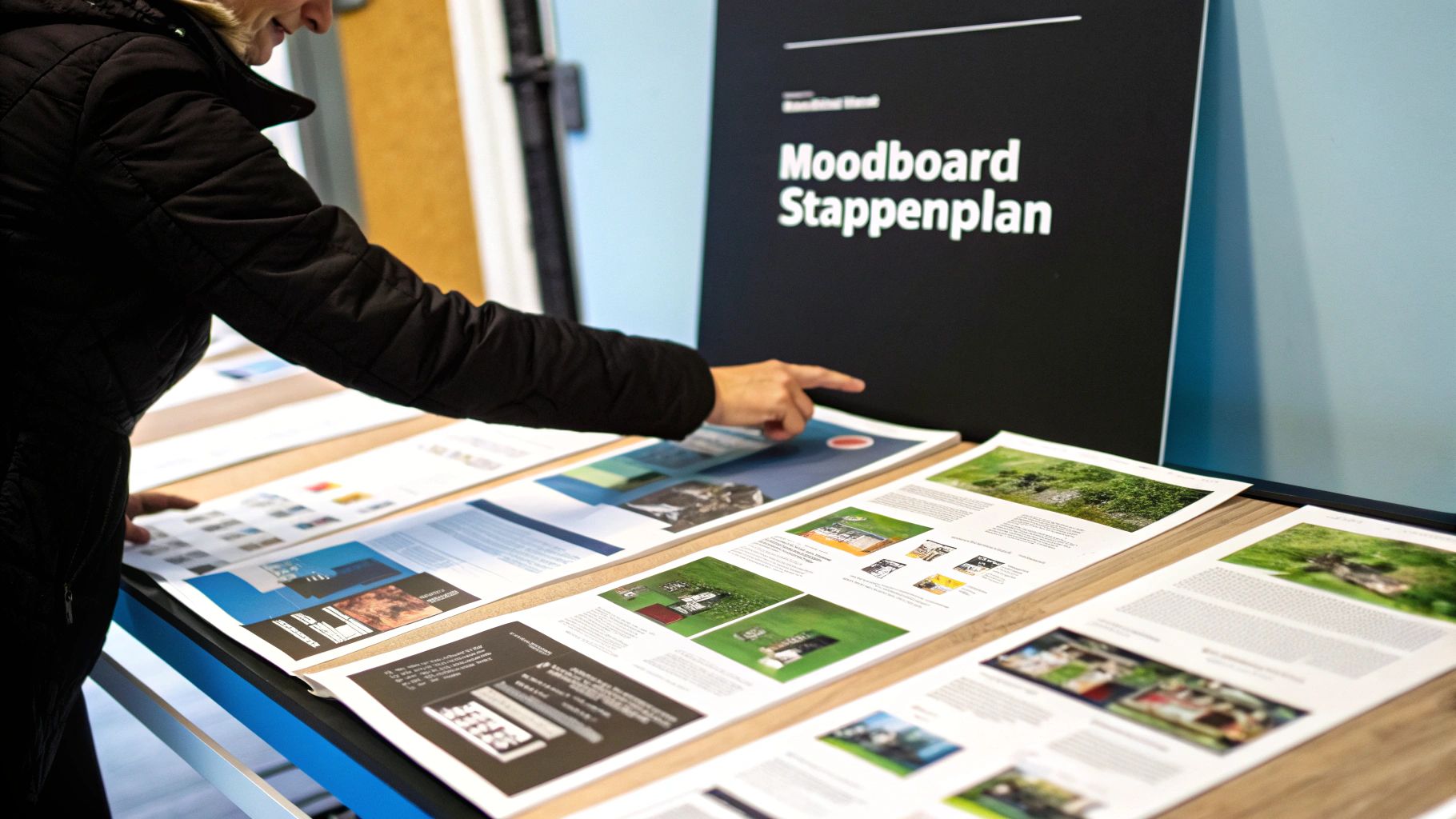
You now have a wealth of inspiration. Time for the most crucial phase: crafting the final story. This is a team exercise in curation. Together, you'll bring all those disparate puzzle pieces together into a compelling visual manifesto.
The trick is in the omission. Be rigorous and select only the images, colors, and textures that truly reinforce the core message. As a group, ask each image: "Does this fit perfectly with the story we want to tell?"
Don't forget: a mood board with ten Powerful visuals that convey the vision with crystal clarity work a thousand times better than a cluttered board with fifty vague ideas. This focused board becomes the visual briefing, a compass that everyone on the team—and the client—instantly understands. This way, you avoid misunderstandings and ensure everyone is on the same page from the start.
The composition: creating balance and flow
With your final selection in hand, it's time to arrange. A good composition is essential, whether you're working digitally on a canvas or with cutouts on a physical board. The goal is to guide the viewer's eye naturally through your story.
Start by establishing a visual hierarchy. Which image is the absolute star of the show? Give that element a prominent place. Group supporting images, textures, and color swatches logically around it.
The best mood boards tell a story without words. They immediately evoke a feeling and make the vision tangible. That's when you notice that feedback and collaboration become almost automatic.
How do you achieve that balance? Here are a few practical tips:
- Clustering by theme: Group similar elements together. All the textures in one corner, the typography examples in another. This creates calm and structure.
- Breathing space is everything: Don't clutter the board. Dare to use white space. It gives the most important elements the attention they deserve and prevents a chaotic impression.
- Focus on a color palette: Choose three to five Main colors and use them consistently. This is the glue that holds the entire composition together and creates unity.
By carefully curating and cleverly organizing the collection, a wealth of scattered inspiration transforms into a powerful communication tool. This becomes the visual anchor for all subsequent creative steps.
Presenting your mood board and collecting feedback
You've gathered ideas, created a mood board... now what? Now comes the most important step: sharing and discussing. A mood board is only truly useful if it sparks conversation. It's the perfect opportunity to test and enrich your vision with insights from your team, client, or other partners.
Don't just share the images, tell the story behind them. Explain why you chose that one photo of a rough concrete wall to authenticity and strength To radiate. Or how that specific color palette perfectly captures the warmth and accessibility of the project. You build a bridge between abstract images and concrete goals, making the choices understandable to everyone.
How to start a real conversation
Nothing is as frustrating as vague feedback. "Nice" or "not really my thing" doesn't help anyone. It's your job as a facilitator to guide the conversation and ask the right questions. Away with the monologue, time for dialogue.
Ask focused, open-ended questions that encourage constructive input:
- "How does this sign make you feel? And does it align with our goals?"
- "Which element really stands out for you? And why that particular element?"
- “If you could change one thing to make the message even clearer, what would it be?”
A good feedback session yields insights, not opinions. The goal is to collaboratively develop a visual language that everyone can agree on and support.
The value of this is clearly recognized in Belgium. At 62% The mood board is used as a fixed reference point for the projects to determine the style and atmosphere. Also notable: 78% of students at Flemish design courses actively use mood boards in presentations. Learn more about how visual data analysis enhances the design process here.
So don't see your mood board as a final destination. It's a living document, a visual guide that grows with your project. As you can see in this animation project for the City of Ghent, a strong mood board ensures that the original vision remains the common thread from start to finish.
Any further questions about mood boards?
Still have a few questions? Don't worry, that's perfectly normal. Below, I'll answer some questions I often get when teams first start using a mood board.
How many images should I put on my mood board?
My advice: go for quality, not quantity. A strong mood board that really tells a story usually only needs 10 to 20 images necessary.
Using too many creates a cluttered image. The core message gets lost in the noise, making it difficult to engage your team or client. Make sure every image you choose truly contributes to the shared vision.
Does a mood board also work for something that is not purely visual?
Absolutely! A mood board is perfect for capturing the atmosphere and feel of a brand story, an event, or even a new business strategy.
You can work perfectly with a mix of keywords, inspiring quotes, and atmospheric images. This way, you make abstract ideas tangible and give everyone on the team a clear, emotional compass.
A mood board is the exploratory phase that establishes the atmosphere (the "why"). A style guide is the concrete, next step with strict rules for how elements should be applied (the "how").
A mood board is therefore the shared, visual starting point. The style guide comes later and establishes the rules for consistent implementation.
Do you already feel the inspiration bubbling, but do you want to take the next step with a professional at your side? At Expert media We translate your vision into a strong brand identity and a compelling website. Curious about what we can do for you? Take a look at our website.

